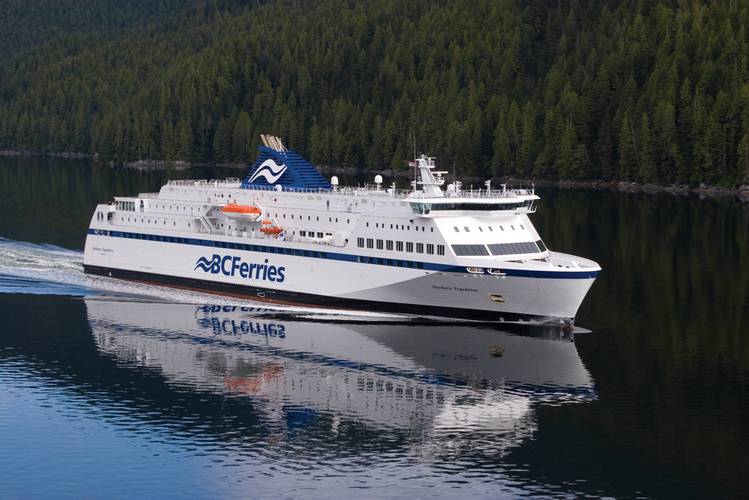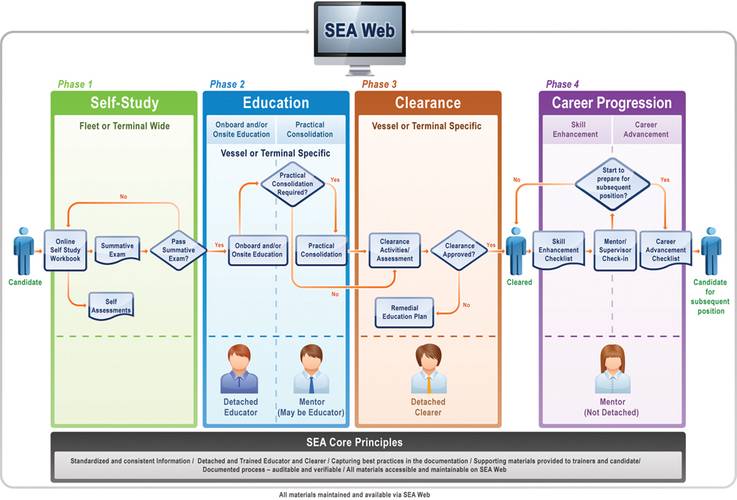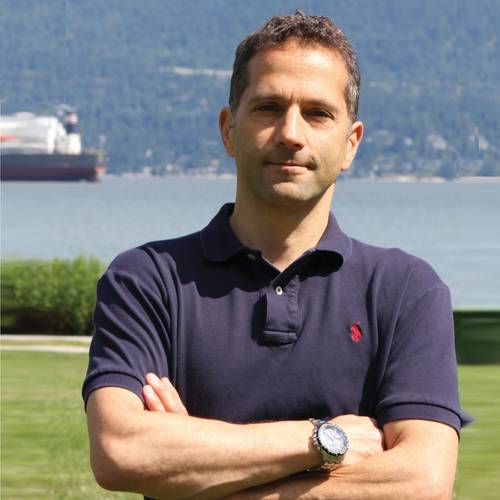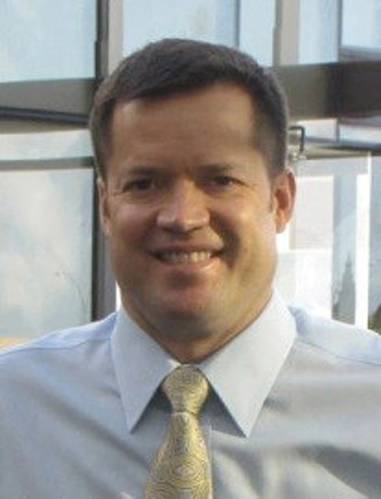SailSafe: A SEA Change for the Better
BC Ferries has improved its safety record, operational practices – and at the same time, its bottom line.
In 2007, British Columbia Ferry Services Inc. (BC Ferries) initiated a union-management joint endeavor to create a world-class safety culture. This program, coined SailSafe, addressed a wide variety of safety-related aspects of BC Ferries’ culture and operational practices. By almost any measure, SailSafe has been a tremendous successf. Although difficult to precisely correlate any one of the many facets of SailSafe to operational statistics, it is not coincidental that accidents have dropped by close to 60 percent, injuries and days lost due to injury have also dropped by the same amount and insurance claims costs have plummeted. A key customer service indicator, on-time performance of the fleet, has also significantly improved.
Key among the SailSafe initiatives was the creation of a new approach to familiarization training called the Standardized Education and Assessment (SEA) program. The SEA program is now in its seventh year of rollout and operation at BC Ferries. Over that time, many lessons have been learned – some the easy way, and others at some cost. This article sheds light on the SEA program and the lessons that have been learned through its implementation. It is meant to provide valuable guidance for any maritime organization either considering or embarking on safety improvements through best-practice training techniques.
SEA Training Program
The SEA program is an intensive blended (online and in-person) approach to job-, vessel- and route-specific training which replaces the previous job-shadowing approach to vessel and terminal familiarization for all 35 operational roles. It is supported by a web-based learning management system (LMS) specifically designed to support training in the maritime context. The SEA program is structured and sustainable, and produces consistent and reliable training outcomes – unlike job shadowing. Like other SailSafe initiatives, the SEA program involves all employees in its creation and sustainment.
Training the “SEA way” involves three core phases designed to ready an employee for performance within a position. It is then followed by a career progression phase which is comprised of two sub-phases focused on first addressing skill enhancement within the new position, and then preparing the employee for career advancement.
The three core phases are self-study, on board education (or “on-site” education for terminal operations) and clearance.
Phase 1 is self-study: In this phase, candidates learn on-line using the LMS, which provides a comprehensive set of job-specific learning resources. The materials include self-tests so the candidates can gauge their progress and readiness to move on to the next module. The goal of this phase is to provide the candidates with the fleet-wide fundamentals for that particular position, bringing them all to a common level prior to embarking on the second phase. Phase 1 culminates in an online exam requiring a pass grade of 80 percent.
Phase 2 is onboard or on-site education: This phase takes place on the vessel or at the terminal with the support of a trained, supernumerary trainer. Depending on the position, between one and four candidates can be simultaneously trained by a single SEA trainer.
Phase 3 is the clearance phase: Here, the candidate is assessed for readiness to perform his or her duties. The clearance phase consists of four levels of measurement including practical demonstrations, verbal scenarios, an online clearance exam and a review with a senior operational supervisor (such as the watch master for a deckhand trainee). The candidate is required to pass all four components of the clearance phase in order to be cleared for duty. Once cleared, they continue their learning through the skill enhancement and career advancement phases.
Lessons Learned
Although SEA has proven to be superior in many ways to the traditional job shadowing approach to ‘training’ and clearing, change management had to be considered throughout all levels of the company. BC Ferries’ strategy to address this challenge was focused on engagement and inclusion at all levels:
Executive support and engagement – The president and CEO’s support and understanding of the SEA principles and approach was fundamental. Additionally, the operational vice-presidents were asked to approve the design document for their individual departments. This program-specific document addressed the duration matrices for the training within the various training scenarios. The approved document also provided objective direction from the VP to the department; all layers below the VP were expected to support the program and its trainers.
Front-line inclusion and engagement – The front-line employees were included in the entire process, from design through development, roll-out and sustainment. Those who had stepped up to participate in the design and development stages were the top trainer recruitment priority. Although perhaps obvious, it bears stating that the greater the understanding of the why and the how of any initiative, the greater the odds of early adopters acting as champions of the process to their colleagues. This is a key aspect of change management.
Curriculum development was a joint effort between BC Ferries subject matter experts and a known and expert instructional design and project management contractor. This gave comfort to both management and operational employees. The return on the investment was dramatic. The approach taken by the project manager was consistently inquisitive and objective and fundamentally focused on ensuring that the front line employees ended up with what they needed.
Program prioritization strategy – due to the higher volume of training need, greatest bang for the buck was achieved by beginning the SEA implementation starting at the lowest level (i.e. deckhand). An important additional unforeseen benefit was that over the duration of the project, we grew our expertise from the lowest level. The corollary of this bottom-up approach was that the understanding of SEA was not as broad nor as deep in the upper ranks, which meant SEA trainers occasionally had to develop their supervisors’ understanding of the SEA trainer role and supervisory support requirements.
Sustainment of the program – this necessitated strategic thinking and effective management that gave careful consideration to resource requirements, the SEA process, and objective performance measures.
Program Sustainment
Initially, the resources dedicated to the project consisted of two in management of design and development and one in LMS development (hosting and IT support). There was also one internal director-level person focusing about one-third of his time to ownership, leadership and part-time resourcing of the team. Completing the team was the cadre of operational employees who participated in working groups and on-site population of learning templates with site, vessel, and route-specific training information. As the program moved up the inaugural department (deck) and across the other three departments (terminals, engineering, catering), the number of part-time trainers grew. Additionally, as the number of programs increased, departmental dedicated expertise and leadership was required, so a SEA manager per department was hired from within our employee base.
It is important to note that while proper staffing is important, training can be improved using any level of staffing with the understanding that speed of progress will match the level of resources applied. There is no harm in the idea of beginning conservatively and with limited resources under the expectation that success has the potential to make additional resources available, if desired, at a later time.
Documented processes were critical in order to ensure that the vision and fundamental tenets of SEA were sustained throughout the project. To develop the processes, key stakeholders were engaged from the employee base, crewing offices, employee relations and the SEA core team. A SEA training process map was created to show the workflows across the company to create awareness, ensure coherence and support sustainment.
Documented measures of performance were critical to sustainment: if you can’t measure it, you can’t manage it. The LMS needed to provide training metrics, ranging from exam performance at the individual question to roll-up reports on programs and ranks of employees.
Recommendations to Industry
Any company considering the transition to a standardized, LMS-enabled training program ignores the experience of early maritime adopters at its own peril. The experience of each company will differ, but there will be many similarities.
Regardless of the organization, a key recommendation is careful consideration of engagement and inclusion. These two levers will help ensure clarity on the impetus (why), the operational requirements (what), the resources, strategy, change management and executive support (how):
- The ‘Why’ – Why a company would forge a new path must be considered and articulated in compelling ways. Typically, these types of initiatives come from the front-line, so it is important to never lose that tone whilst honing the elevator speeches, the stakeholder/enabler engagement sessions and even the executive briefings.
- The ‘What’ – What exactly is required? How best to determine the ‘what’ requires consideration of a range of items, from the regulatory requirements all the way through to the front-line employees’ real training issues. Understanding their needs and addressing current training challenges and shortcomings are key elements of a successful implementation.
- The ‘How’ – How best to address these needs must be realistic. Having a training delivery plan that is not affordable is clearly poor planning and will lead to expedited failure. Iterative approaches are typically best when it comes to design and development. A conservative beginning with a small group in a pilot format will allow the project owner to gather key decision and planning-enabling data, ensuring long-term success. This underscores the point that it is not possible to have all the answers at the outset of the project; each implementation is a learning experience. But with some initial planning and a cautious and iterative approach to growth, rest assured that the answers will emerge over time and success will be achieved.
BC Ferries: a SEA Change for the Better
The SEA program at BC Ferries is alive and well as it shifts gears into sustainment. Many lessons have been learned that industry colleagues will hopefully be able to benefit from as they consider their own training strategy. The SEA process has provided much-improved structure, consistency and quality over traditional job-shadowing. The process has had significant positive impact on employee training as well as on employee soft-skills development. Employee buy-in is now very high. Critical thinking and objectivity, as well as collaborative planning and communication skills have all been honed through SEA.
The Authors
Jeff Joyce is BC Ferries’ Director of Fleet Operations and has been the SEA Project Owner since its inception in 2008. Murray Goldberg is CEO of Marine Learning Systems (www.MarineLS.com). An eLearning researcher and developer, his software has been used by 14 million people worldwide.
(As published in the January 2016 edition of Marine News - http://magazines.marinelink.com/Magazines/MaritimeNews)
























